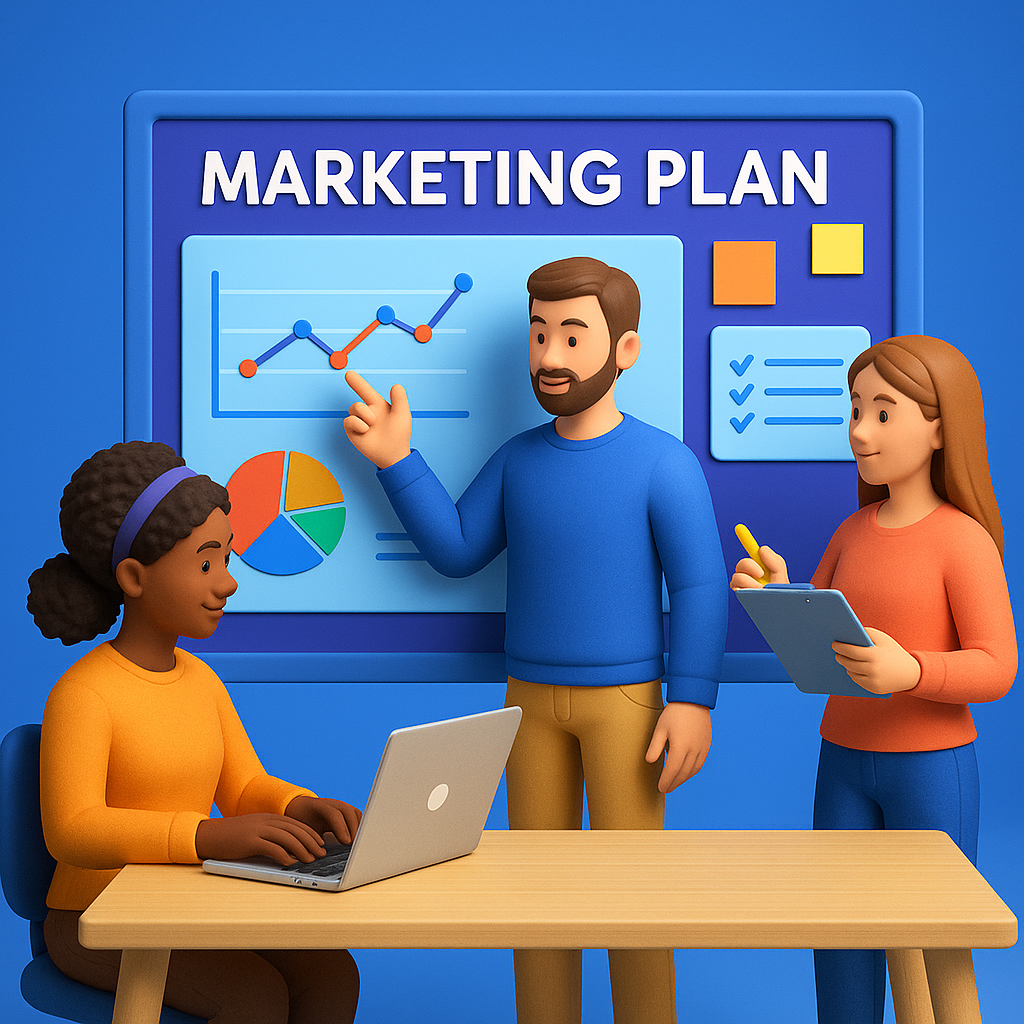Step 1: Define Your Campaign Objective
Before launching anything, get clear on your primary goal.
Examples:
- Raise $50,000 at your annual gala
- Sell 500 raffle tickets
- Attract 250 new donors
- Launch a recurring giving program
👉 Write your objective clearly and make it measurable.
| Campaign Name | Objective | Start Date | End Date | KPI |
|---|---|---|---|---|
| Annual Gala Auction | Raise $50,000 | 04/10 | 05/30 | Total revenue, donor count |
Turn Your Marketing Plan into Auction Results
You’ve got the plan—now bring it to life. Launch your next fundraiser on CharityAuctions.com and turn every email, post, and campaign into real bids and donations.
Start Your AuctionStep 2: Identify Your Target Audience
Understanding who you’re trying to reach determines how to reach them.
Key Segments:
- Existing donors / warm list
- Local businesses (sponsorship / item donors)
- High-capacity bidders
- Social media followers
- Email subscribers
- Community partners
| Segment | Channel | Message Style | CTA |
|---|---|---|---|
| Warm donors | Impact-driven | “RSVP Today” | |
| Sponsors | Direct outreach | Value exchange | “Partner With Us” |
Step 3: Craft Your Core Message
One campaign → one clear message.
Messaging Framework:
- Problem: Why your cause matters
- Solution: How the event/fundraiser helps
- Impact: What donations accomplish
- Action: What they can do right now
Example Core Message:
“Every bid helps fund meals for families in need. Join us to make a difference.”
👉 Keep the CTA short and active: Bid Now, Donate Today, Join the Gala, Get Tickets.
Related Reading
Step 4: Map Your Content Strategy
Plan your content cadence so each message builds momentum.
| Week | Channel | Content | CTA |
|---|---|---|---|
| Week 1 | Email + Social | Save the Date + Early Access | Register |
| Week 2 | Social + Blog | Behind the Scenes | Follow / Share |
| Week 3 | Paid Ads | Auction Item Teasers | Bid Early |
| Week 4 | Email Blast | Last Chance Reminder | Bid Now |
👉 Pro tip: Repurpose content across channels. One story can fuel email, reels, LinkedIn, and paid ads.
Step 5: Select Your Channels
Recommended Channels for Nonprofits:
- 📩 Email Marketing (warm list conversion)
- 📱 Organic Social (Instagram, Facebook, LinkedIn)
- 📰 Blog / SEO (long-term traffic)
- 💰 Paid Social (targeted reach)
- 📢 PR / Local Media
- 🤝 Partner Amplification (board, sponsors, ambassadors)
| Channel | Priority | Budget | Owner | Notes |
|---|---|---|---|---|
| High | $0 | Marketing team | Weekly sends | |
| Paid Ads | Medium | $500 | Agency | Retargeting warm list |
Step 6: Launch Plan & Timeline
Break your launch into clear phases.
- Pre-Launch (3–4 weeks before)
- Announce event
- Open ticket sales / auction preview
- Build email list & retargeting audiences
- Launch Week
- Push big announcements
- Showcase auction items
- Email + paid ads + influencer amplification
- Final Push (Last 72 hours)
- Urgency campaigns (SMS, email)
- “Bid Now” or “Last Chance” messages
- Leaderboard / real-time updates
- Post-Event
- Thank donors and sponsors
- Share impact stories
- Encourage recurring gifts or next event registration
| Phase | Timeline | Key Action |
|---|---|---|
| Pre-launch | Mar 1–20 | Teasers, list building |
| Launch | Mar 21–28 | Push event |
| Final push | Mar 29–31 | Urgency |
| Post-event | Apr 1–10 | Thank you, follow-up |
Step 7: Conversion & Tracking Metrics
Measure what matters — not just clicks.
| Metric | Why It Matters |
|---|---|
| Email Open / Click Rate | Engagement |
| Registration / Bidding | Conversion |
| Average Gift Size | Revenue growth |
| ROAS (Ad Spend) | Efficiency |
| Post-event Donor Retention | Long-term impact |
Track through:
- Google Analytics / UTM tags
- Auction platform analytics
- CRM / email reporting
You Might Also Like
Step 8: Team Roles & Responsibilities
| Role | Person | Responsibility |
|---|---|---|
| Campaign Lead | Timeline + execution | |
| Content Creator | Copy + graphics | |
| Email Manager | Drip + blast campaigns | |
| Social Media | Posting schedule | |
| Paid Ads | Budget + targeting | |
| PR / Outreach | Partners + press |
Clear ownership prevents last-minute chaos.
Step 9: Budget & Resources
| Item | Estimated Cost | Actual | Notes |
|---|---|---|---|
| Paid Ads | $500 | ||
| Design / Creative | $250 | ||
| Platform Fees | $300 | ||
| Printing | $150 | ||
| Misc | $200 |
👉 Track costs early — marketing ROI is real in fundraising.
Step 10: Post-Campaign Review
Analyze, learn, and scale.
- What channels drove the most traffic?
- What content converted best?
- Which audience segments performed best?
- What bottlenecks slowed execution?
Post-event deliverables:
- Final KPI report
- Wins & gaps summary
- Playbook updates for the next campaign
More Resources
Pro Tips for Nonprofit Marketing Success
- Keep messaging emotional but clear
- Use automation to free up staff time
- Showcase real stories and impact
- Lean into deadline-driven campaigns
- Use consistent branding across channels
Frequently Asked Questions
What is a nonprofit marketing plan?
A nonprofit marketing plan is a short roadmap that defines your fundraising goal, audience, messaging, channels, timeline, and success metrics. It aligns your team so every activity moves donors toward one clear outcome.
How do I use this template quickly?
- Set one measurable campaign objective.
- List 3–5 audience segments and a CTA for each.
- Draft a one-sentence core message.
- Pick channels, owners, and a 4-phase timeline.
- Add KPIs, budget, and post-event review tasks.
What makes a strong campaign objective?
Use a SMART target tied to impact, e.g., “Raise $50,000 by May 30” or “Sell 500 raffle tickets.” Include a start date, end date, and the KPI that proves success.
How should I segment our audience for better results?
- Warm donors: impact-driven emails.
- Sponsors/businesses: value-exchange outreach.
- High-capacity bidders: personal invites.
- Followers/subscribers: social + newsletter CTAs.
How do I write a one-sentence core message and CTA?
Follow Problem → Solution → Impact → Action: “Every bid funds local meals—join the gala and Bid Now.” Keep verbs active: “Donate Today,” “Get Tickets,” “Register.”
Which channels should nonprofits prioritize for auctions and events?
- Email for warm conversions.
- Organic social for storytelling.
- Paid social for targeted reach/retargeting.
- Blog/SEO for evergreen discovery.
- PR/partners to amplify trust.
What does a simple 4-phase launch timeline look like?
- Pre-launch (3–4 weeks): announce, build list, open tickets/preview.
- Launch week: big pushes, item spotlights, partner shares.
- Final 72 hours: urgency via email/SMS and leaderboards.
- Post-event: thanks, impact stories, recurring asks.
How should I plan content across the month?
- Week 1: Save-the-date + early access.
- Week 2: Behind-the-scenes + blog post.
- Week 3: Item teasers + paid ads.
- Week 4: Last-chance blast + daily social reminders.
Which KPIs should we track for fundraising campaigns?
- Email open/click rate (engagement).
- Registration/bidding rate (conversion).
- Average gift size (revenue growth).
- ROAS for ads (efficiency).
- Post-event donor retention (long-term impact).
How do we set up reliable tracking and attribution fast?
Add UTM parameters to key links, enable analytics on event pages, and align goals in your CRM and auction platform. Create a weekly KPI sheet to review leading indicators by channel.
Which team roles keep launches on track?
- Campaign Lead: timeline/owners.
- Content Creator: copy/graphics.
- Email Manager: drips/blasts.
- Social Manager: schedule/community.
- Paid Ads: budget/targeting.
- PR/Outreach: partners & press.
What’s a realistic starter marketing budget for an event?
A simple plan may allocate funds like: paid ads $500, design $250, platform fees $300, printing $150, misc $200. Track planned vs. actual so you can improve ROAS next time. General information, not financial advice.
Any email best practices for nonprofit campaigns?
- Send weekly, then increase frequency in final 72 hours.
- Use clear subject lines with one CTA.
- Show impact with a short story + image.
- Segment sends to donors, sponsors, and prospects.
How should we promote on social without spamming followers?
Mix value and asks: behind-the-scenes clips, item spotlights, volunteer shout-outs, and countdowns. Pair every post with a simple CTA and leverage ambassadors/board members for amplification.
What drives urgency in the last 72 hours before closing?
- Daily emails/SMS with deadlines.
- Leaderboard or “bids needed to win.”
- Match challenges and limited-time perks.
- Live item teasers and progress updates.
What should our post-event follow-up include?
- Thank-you notes to donors, bidders, and sponsors.
- Impact recap with photos and quick stats.
- Survey + next-step CTAs (recurring gifts, next event).
- Final KPI report and lessons learned.
Do you have a short outreach script we can copy?
Subject: Join us to make every bid count
Body: “Hi [Name]—on [date], we’re raising funds for [cause]. Your participation helps [impact]. Can we count on you to [donate/bid/sponsor]? Here’s your link: [URL]. Thank you for making a difference!”
How can we repurpose content to save staff time?
Turn one story into a blog, email, LinkedIn post, short video, and a donor spotlight. Keep a shared asset folder and reuse templates for every campaign.
What common mistakes should we avoid?
- Multiple conflicting goals.
- No owner per channel.
- Late promotion and weak CTAs.
- Tracking set up after launch instead of before.
Any compliance or privacy tips for marketing outreach?
Use opt-in lists, honor unsubscribe requests, and secure donor data with strong permissions and payment protections. Follow applicable email/SMS and privacy regulations in your region. General information, not legal advice.
💡 Try this in ChatGPT
- Summarize the article "Marketing Plan Template for Nonprofits & Charity Auctions" from https://www.charityauctionstoday.com/p/rlp-marketing-plan-template/ in 3 bullet points for a board update.
- Turn the article "Marketing Plan Template for Nonprofits & Charity Auctions" (https://www.charityauctionstoday.com/p/rlp-marketing-plan-template/) into a 60-second talking script with one example and one CTA.
- Extract 5 SEO keywords and 3 internal link ideas from "Marketing Plan Template for Nonprofits & Charity Auctions": https://www.charityauctionstoday.com/p/rlp-marketing-plan-template/.
- Create 3 tweet ideas and a LinkedIn post that expand on this FAQ topic using the article at https://www.charityauctionstoday.com/p/rlp-marketing-plan-template/.
Tip: Paste the whole prompt (with the URL) so the AI can fetch context.
Share this article
Tom Kelly, TEDx speaker and CEO of CharityAuctions.com, helps nonprofits raise millions through auctions and AI. He hosts The Million Dollar Nonprofit podcast and inspires leaders to live their legacy, not just leave it.
Table of contents
Create Your Auction
Raise 40% more with smart bidding tools


